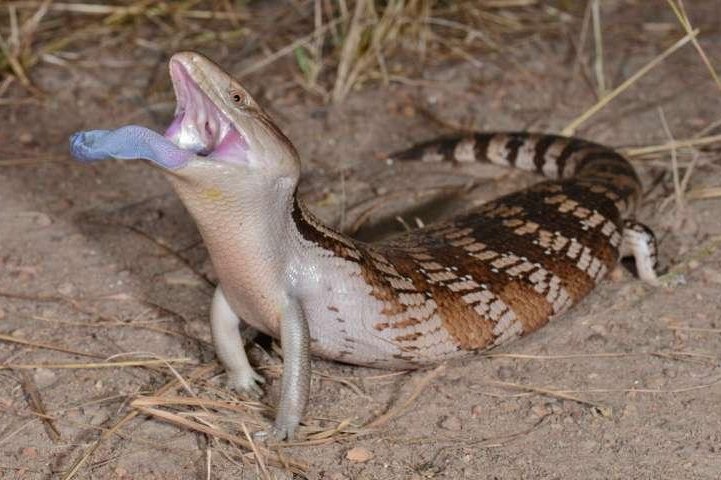A bluetongue skink unfurls its ultraviolet tongue to scare away an attacker. Photo by Shane Black/Springer
June 7 (UPI) -- When most of us stick our tongue out, it's to taunt or tease -- or we're at the doctor's office. When the bluetongue skink sticks out its tongue, its trying to scare away would-be predators and avoid being eaten.
A new investigation of the lizard's unique defensive technique showed the back of the species' tongue is more reflective of ultraviolet light, making it more luminous than the front. By reflecting ultraviolet blue light, the back of the tongue -- which only appears when a direct attack is imminent -- can startle or disorient the lizard's enemies.
The medium-large lizard species belongs to the genus Tiliqua. They are native to Australia, eastern Indonesia and Papua New Guinea.
To better understand the lizard and its tongue's optical properties, scientists studied the largest of the blue-tongued subspecies, the northern blue-tongued skink.
Found in northern Australia, the lizard camouflage helps it blend into the dry, reddish-tinted desert and scrubland, but many of the skink's most common predators possess ultraviolet vision.
Using a portable spectrophotometer to analyze the tongues of 13 specimens, scientists were able to confirm the species' tongue reflects UV-blue light. They also determined the back of the lizard's tongue is nearly twice as bright as the front.
Researchers also simulated attacks on lizard specimens to observe the defensive deployment of the tongue.
"The lizards restrict the use of full-tongue displays to the final stages of a predation sequence when they are most at risk, and do so in concert with aggressive defensive behaviors that amplify the display, such as hissing or inflating their bodies," lead researcher Arnaud Badiane, a scientist at Macquarie University in Sydney, said in a news release. "This type of display might be particularly effective against aerial predators, for which an interrupted attack would not be easily resumed due to loss of inertia."
The research team found the more intense the attack, the more likely a lizard was to stick out their tongue and stick out more of it.
"The timing of their tongue display is crucial," Badiane said. "If performed too early, a display may break the lizard's camouflage and attract unwanted attention by predators and increase predation risk. If performed too late, it may not deter predators."
Researchers shared their analysis of the blue-tongued skink this week in the journal Behavioral Ecology and Sociobiology.















